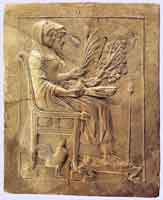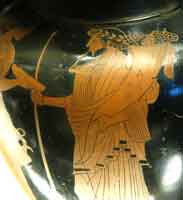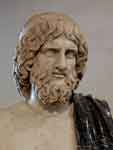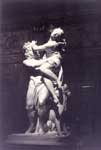.
For let me tell you, Socrates, that when a man thinks himself to be near death, fears and cares enter into his mind which he never had before; the tales of a world below and the punishment which is exacted there of deeds done here were once a laughing matter to him, but now he is tormented with the thought that they may be true: either from the weakness of age, or because he is now drawing nearer to that other place, he has a clearer view of these things; Plato, The Republic
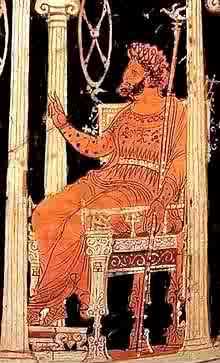
Hades on a red figure vase, c. 400 BC.
Hades (Greek: ᾍδης - Hadēs or Ἅιδης - Háidēs, Άδης) ("unseen") means both the ancient Greek abode of the dead and the god of that underworld. The word originally referred to just the god; haidou, its genitive, was short for "the house of Hades", and eventually the nominative, too, came to designate the abode of the dead. (A related Hebrew word, She'Ol, for the abode of the dead also meant literally "unseen.")
The corresponding Roman god was Pluto (from Greek Πλουτων), Dis Pater or Orcus; the corresponding Etruscan god was Aita. "Hades" is sometimes employed by Christians as a classicizing euphemism for their Hell, which otherwise has few of the attributes of Hades.
Hades: the place
There were several sections of Hades, including the Elysian Fields (contrast the Christian Paradise or Heaven), and Tartarus, (compare the Christian Hell). Greek mythographers were not perfectly consistent about the geography of the Afterlife
A contrasting myth of the Afterlife concerns the Garden of the Hesperides, often identified with the Isles of the Blessed.
In Roman mythology, an entrance to the underworld located at Avernus, a crater near Cumae, was the route Aeneas used to descend to the Underworld. By synecdoche, "Avernus" could be substituted for the underworld as a whole. The Inferi Dii were the Roman gods of the underworld.
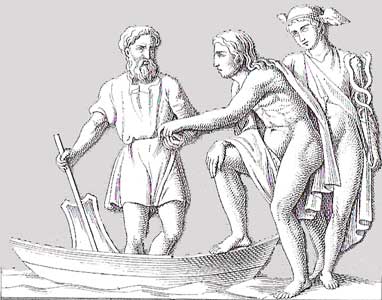
Charon, a dead and Hermes Psychopompos
The deceased entered the underworld by crossing the river Acheron, ferried across by Charon (kair'-on), who charged an obolus, a small coin for passage, placed under the tongue of the deceased by pious relatives. Paupers and the friendless gathered forever on the near shore. The far side of the river was guarded by Cerberus, the three-headed dog defeated by Heracles (Roman Hercules). Beyond Cerberus, the shades of the departed entered Tartarus, the land of the dead.
The five rivers of Hades are Acheron, Cocytus, Phlegethon, Lethe and Styx. See also Eridanos.
The first region of Hades comprises the Fields of Asphodel, described in Odyssey xi, where the shades of heroes wander despondently among lesser spirits, who twitter around them like bats. Only libations of blood offered to them in the world of the living can reawaken in them for a time the sensations of humanity (compare vampires).
Beyond lay Erebus, which could be taken for a euphonym of Hades, whose own name was dread. There were two pools, that of Lethe, where the common souls flocked to erase all memory, and the pool of Mnemosyne ("memory"), where the initiates of the Mysteries drank instead. In the forecourt of the baleful palace of Hades and Persephone sit the three judges of the Underworld: Minos, Rhadamanthys and Aeacus. There at the trivium sacred to Hecate, where three roads meets, souls are judged, returned to the Fields of Asphodel if they are neither virtuous nor evil, sent by the road to Tartarus if they are impious or evil, or sent to Elysium with the heroic blessed.

Pluto with Cerberus (and the Planet Pluto, or actually not anymore a Planet)
Hades: the person
In Greek mythology, Hades (the "unseen"), the god of the underworld, was a son of the Titans Cronus and Rhea. He had three older sisters, Hestia, Demeter, and Hera, as well as two younger brothers, Poseidon and Zeus: together they accounted for half of the Olympian gods.
Cronus, fearing that his children would grow to depose him, devoured them upon birth, with the exception of Zeus and, according to some accounts, Hera. Upon reaching adulthood Zeus managed to force his father to disgorge his siblings. After their release the six younger gods, along with allies they managed to gather, challenged their parents and uncles for power in Titanomachy, a divine war. The war lasted for ten years and ended with the victory of the younger gods. Following their victory Hades and his two younger brothers, Poseidon and Zeus, drew lots for realms to rule. Zeus got the sky, Poseidon got the seas, and Hades received the underworld, the unseen realm to which the dead go upon leaving the world. Metaphorically, each one received one object: Zeus, a thunder spear; Poseidon, a trident; and Hades, a helmet that gave invisibility to its carrier.
Hades obtained his eventual consort, Persephone, through trickery, a story that connected the ancient Eleusinian Mysteries with the Olympian pantheon.
Hades ruled the dead, assisted by demons over whom he had complete authority. He strictly forbade his subjects to leave his domain and would become quite enraged when anyone tried to leave, or if someone tried to steal his prey from him.
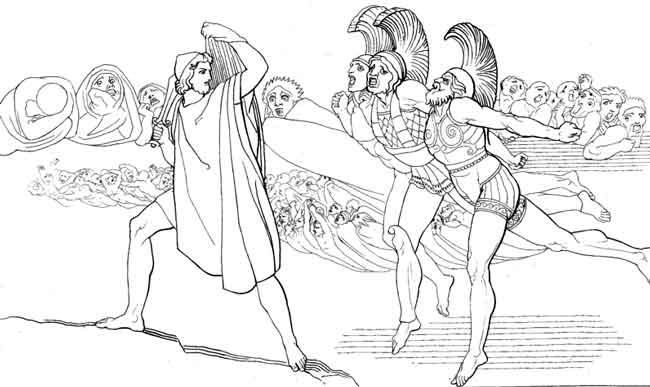
Odysseus in Hades, John Flaxman
Besides Heracles, the only other living persons who ventured to the Underworld were all heroes: Odysseus, Aeneas, and Theseus. None of them was especially pleased with what they witnessed in the realm of the dead. In particular, the Trojan War hero Achilles, whom Odysseus met in Hades (although some believe that Achilles dwells in the Isles of the Blest), said:
"Do not speak soothingly to me of death, glorious Odysseus. I should choose to serve as the hireling of another, rather than to be lord over the dead that have perished."
—Achilles' soul to Odysseus. Homer, Odyssey 11.488
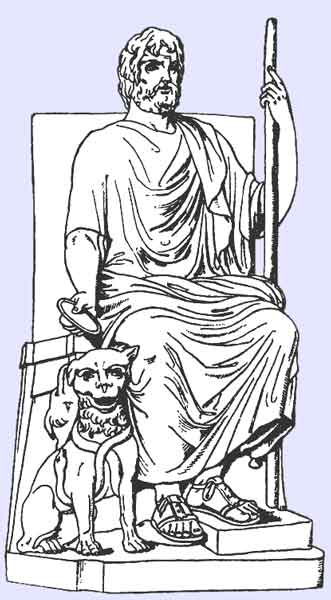
Hades, Villa Borghese, Rome
Worship
Hades was a fearsome figure to those still living; in no hurry to meet him, they were reticent to swear oaths in his name. To many, simply to say the word "Hades" was frightening. So, a euphemism was pressed into use. Since precious minerals come from under the earth (i.e., the "underworld" ruled by Hades), he was considered to have control of these as well, and was referred to as "Plouton" (related to the word for "wealth"), whence the Roman Pluto. Sophocles explained referring to Hades as "the rich one" with these words: "the gloomy Hades enriches himself with our sighs and our tears." In addition, he was called Clymenus ("notorious"), Eubuleus ("well-guessing"), and Polydegmon ("who receives many").
Although he was an Olympian, he spent most of the time in his dark realm. Formidable in battle, he proved his ferociousness in the famous Titanomachy, the battle of the Olympians versus the Titans, which established the rule of Zeus.
Because of his dark and morbid personality he was not especially liked by either the gods nor the mortals. His character is described as "fierce and inexorable", and of all the gods he was by far most hated by mortals. He was not, however, an evil god, for although he was stern, cruel, and unpitying, he was still just. Hades ruled the Underworld and therefore most often associated with death and was feared by men, but he was not Death itself — the actual embodiment of Death was Thanatos.
When the Greeks prayed to Hades, they banged their hands on the ground to be sure he would hear them. Black animals, such as sheep, were sacrificed to him, and it is believed that at one time even human sacrifices were offered. The blood from sacrifices from Hades dripped into a pit so it could reach him. The person who offered the sacrifice had to turn away his face. Every hundred years festivals were held in his honor, called the Secular Games.
Hades' weapon was a two-pronged fork, which he used to shatter anything that was in his way or not to his liking, much as Poseidon did with his trident. This ensign of his power was a staff with which he drove the shades of the dead into the lower world.
His identifying possessions included a famed helmet, given to him by the Cyclopes, which made anyone who wore it invisible. Hades was known to sometimes loan his helmet of invisibility to both gods and men (such as Perseus). His dark chariot, drawn by four coal-black horses, always made for a fearsome and impressive sight. His other ordinary attributes were the Narcissus and cypress plants, the Key of Hades and Cerberus, the three-headed dog. He sat on an ebony throne.
Few temples of Hades known (Elis, Eleusis)
Hades in art
Hades is rarely represented in classical arts, save in the Rape of Persephone. Hades was a graceful dark figure.
Persephone
The consort of Hades, and the archaic queen of the Underworld in her own right, before the Hellene Olympians were established, was Persephone, represented by the Greeks as daughter of Zeus and Demeter. Persephone did not submit to Hades willingly, but was abducted by him while picking flowers with her friends. Hades loved Persphone so deeply that he did not free her from the underworld. Persephone's mother missed her and without her daughter by her side she cast a curse on the land and there was a great famine. Hades tricked Persephone into eating six seeds, which ment that she would be unable to leave the underworld even with the help of Zeus. Persephone knew of her mother's depression and asked Hades to return her to the land of the living, on the condition that she would stay with him for six months a year. Every year Hades fights his way back to the land of the living with Persephone in his chariot. In the months that Persephone is gone there is always famine ( winter).

Orpheus in Hades, 1865, Jules Machard (1839-1900)
Orpheus and Eurydice
Hades showed mercy only once: Because the music of Orpheus was so hauntingly sad, he allowed Orpheus to bring his wife, Eurydice, back to the land of the living as long as she walked behind him and he never tried to look at her face until they got to the surface. Orpheus agreed but, yielding to the temptation to glance backwards, failed and lost Eurydice again, to be reunited with her only after his death.
Leuce and Mintho
Like his brother Zeus and other ancient gods, Hades was not the most faithful of husbands. He pursued and loved the nymph Mintho and to punish her for this, his jealous wife Persephone turned Mintho into the plant called mint. Likewise, the nymph Leuce, who was also ravished by him, was metamorphosed by Hades into a white poplar tree after her death.
Theseus and Pirithous
Hades imprisoned Theseus and Pirithous, who had pledged to marry daughters of Zeus. Theseus chose Helen and together they kidnapped her and decided to hold onto her until she was old enough to marry. Pirithous chose Persephone. They left Helen with Theseus' mother, Aethra and travelled to the underworld. Hades pretended to offer them hospitality and set a feast; as soon as the pair sat down, snakes coiled around their feet and held them there. Theseus was eventually rescued by Heracles.
Heracles
Heracles' final labour was to capture Cerberus. First, Heracles went to Eleusis to be initiated into the Eleusinian Mysteries. He did this to absolve himself of guilt for killing the centaurs and to learn how to enter and exit the underworld alive. He found the entrance to the underworld at Tanaerum. Athena and Hermes helped him through and back from Hades. Heracles asked Hades for permission to take Cerberus. Hades agreed as long as Heracles didn't harm him, though in some versions, Heracles shot Hades with an arrow. When Heracles dragged the dog out of Hades, he passed through the cavern Acherusia.
Other names
Άιδης
Aides
Aiidoneus
Haides
Zeus Katachthonios "Zeus of the Underworld
"Pluton
Plouton "The Rich One"
The Unseen One
In Roman Mythology
Pluto
Pluton
Dis
Dis Pater
Orcus
New Testament usage of "Hades"
The Greek New Testament uses hades several times, with various connotations of bodily decay and the power of death, none of them applicable to the Hades of Greek mythology, unless it were Luke 16:23 [1] (http://www.DataRat.net/DR/Lex-H.html#Hades).
| Olympians |
| Zeus and Hera |
| Poseidon, Hades, |
| Hestia, Demeter, |
| Aphrodite, Athena, |
| Apollo, Artemis, |
| Ares, Hephaestus, |
| Hermes, Dionysus |
| The Greek Underworld | |
|---|---|
| Residents: | |
| Geography: | |
|
|
| Famous inmates: | |
| Chthonic deities |
| Hades and Persephone, |
| Gaia, Demeter, Hecate, |
| Iacchus, Trophonius, |
| Triptolemus, Erinyes |
| Heroes and the Dead |
- http://homepage.mac.com/cparada/GML/Underworldmap.html
See also : Greek Mythology. Paintings, Drawings
| Ancient Greece
Science, Technology , Medicine , Warfare, , Biographies , Life , Cities/Places/Maps , Arts , Literature , Philosophy ,Olympics, Mythology , History , Images Medieval Greece / Byzantine Empire Science, Technology, Arts, , Warfare , Literature, Biographies, Icons, History Modern Greece Cities, Islands, Regions, Fauna/Flora ,Biographies , History , Warfare, Science/Technology, Literature, Music , Arts , Film/Actors , Sport , Fashion --- |
Retrieved from "http://en.wikipedia.org"
All text is available under the terms of the GNU Free Documentation License

